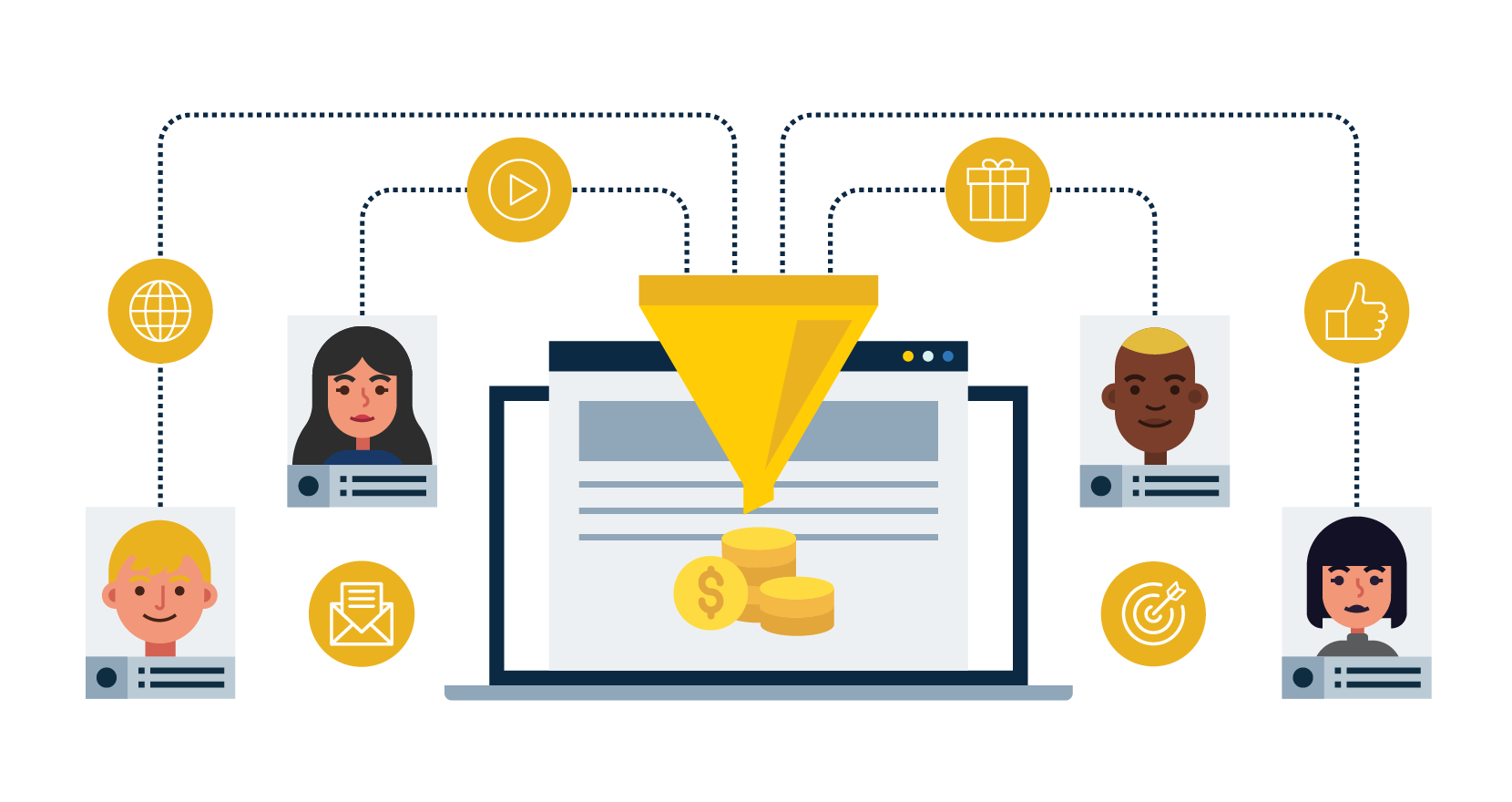


Simply put, are four general ways that leads come into your funnel:
1- Names on a list coming from a customer database. (Here’s how to Quickly Create an Effective Customer Database).
2- Referrals from current customers.
3- Responses to advertising
4- Inbound marketing and SEO.
These four ways boil down into two broader categories that we’ll briefly go over:
Depending on your sales/marketing process, there may be a time when you are trying to reach those who are “unaware” of your brand (or even your industry). For example, you advertise on any platform (e.g. Facebook, Google Adwords) hoping to eventually get people/businesses to give you their contact information. If they were unaware, they become aware through your ad.
Funnels are set up to feed content and other items to leads in order to provoke a response and gauge readiness to buy. Many organizations score their leads, and the score rises when the lead makes a move, clicks on a CTA, or otherwise engages with your content or marketing material.
Once the lead reaches the right level of perceived value, they are ready to move to the next phase of the sales process.
These are a bit different. If your sales process is less about advertising and more about finding quality prospects to cold pitch, your leads can be leads before they are aware of your brand.
This may sound confusing for some, so we’ll do another example to contrast the whole mess.
Example: You hunt for high quality leads and the names of potential decision makers to email and cold call in order to get the conversation started and see if said lead is a fit for your product.
For the cold outreach, you’re also going to want to figure out whether your lead is a suspect or a prospect quickly.
Essentially, suspects are leads that look good but have no real interest in making a deal. They can be identified and thrown out quickly.
Prospects are the real deal. They need your stuff and are close to buying.
You may want to do an “are we a fit” call to separate the suspects from the prospects; it’s the best way for most businesses.
With that out of the way, we’ll get into the different labels that you may place on a lead. Keep the difference between cold outreach and traditional marketing in mind, they’ll come into play throughout.
Once a lead becomes a lead they are ready for your marketing efforts and become an MQL.
All this means is that the lead is ready to receive materials and content that will move them closer and closer to the point of becoming sales ready. Depending on how you acquired the lead, your process here will again be different.
This title represents a stage that not all organizations have, but most should (not all, of course). Once a lead reaches the score that indicates they may be ready for a sales interaction, too many businesses ship them to the sales department to be a part of that process. Often times this creates a divide between the marketing team and the sales reps. When it doesn’t end up in a conversion, it’s not good for anybody.
Sure, communication between departments goes a long way. But what if you could have a step added to the process that will help your marketing team score leads better (over time) while ensuring only the best leads move onto our next label?
Once a lead meets the prerequisites to move to sales, schedule an exploratory call with the lead and a sales rep. Not a sales call/demo, but a call that further qualifies the lead’s readiness. There are a few basic things you are looking to find out on this call:
· Do their needs fit our solution?
· Are they looking for a replacement solution?
· Have you identified the decision maker?
· Are they ready to make a move?
Doing this sales accepted lead process helps in several ways including:
· Immediate feedback to marketing on the lead scoring.
· Sales is more informed about the lead before they call, instead of being left “in the dark”.
· The process seems more professional to the lead and could be used to prime them for the sales call later.
Note: If you handle the entire process from lead to close (cold outreach), you won’t call the lead an SAL.
That said, you could (and should) do a similar call to figure out whether the lead is a fit and qualified for a pitch.
After this style of call, it’s either back to the funnel (or email cadence), gone forever, or onto the sales process.
The last stage a lead will advance to being sales qualified. For some organizations / businesses this means that they’ve hit the lead score and went straight to sales for processing, or the sales team has had a preliminary crack at them to give the final go ahead and now they are actively pursuing the close of the deal.
If you have sales reps (or you’re one), this stage requires both traditional marketing efforts and cold outreach. You are ready to do a demo, make a pitch, and have that final conversation to ask for the deal.
More importantly, the lead is ready to talk.
Now, they should be at a point that a decision needs to be made. You want to sell the product / service, that’s clear.
It’s when they are truly considering buying that they are sales qualified.
To bookend all of those different ways to label a lead, we thought it’s best to end with the point at which a lead is no longer a lead.
As you may have figured out—there are three choices at the end of a sales call: Yes, No, and Maybe.
We’ll get to maybe in a minute. Other than the maybe, there are two answers to deal with on the account.
· Closed Won: You got the deal, it’s done. The money’s in house and it will show up on an upcoming paycheck (if you’re on a commission structure).
· Closed Lost: You didn’t get the deal and the lead expressed that they would not be purchasing your product / service / solution.
Even if you’ve done the best screening you can think of, you’ll still have a lot of maybes. These will go back into your funnel (if you’re running a marketing funnel).
If you’re doing cold outreach, they’ll go back in “the rolodex” for 3-6 months.
You’d be surprised by just how many leads will liven up after a few months and end up signing a deal. So don’t get discouraged.
Even though this blog is a fly-by of the various ways to identify a lead in your sales funnel, we can hope that it has helped you see the value of proper labeling.
Take it as a look at the big picture to see how the term “lead” is used in various ways throughout the process.
There are tons of sales definitions (many of which we’ve gone over in the blog), but without a grasp of the “lead” a new sales rep will be lost.
Hopefully, our explanations will help you and your team to be better equipped and ready to hit the phones (and email).
VOILA expert team can help you out - just like we’ve helped many other businesses and organizations. All you need to do is get in touch with our expert team.